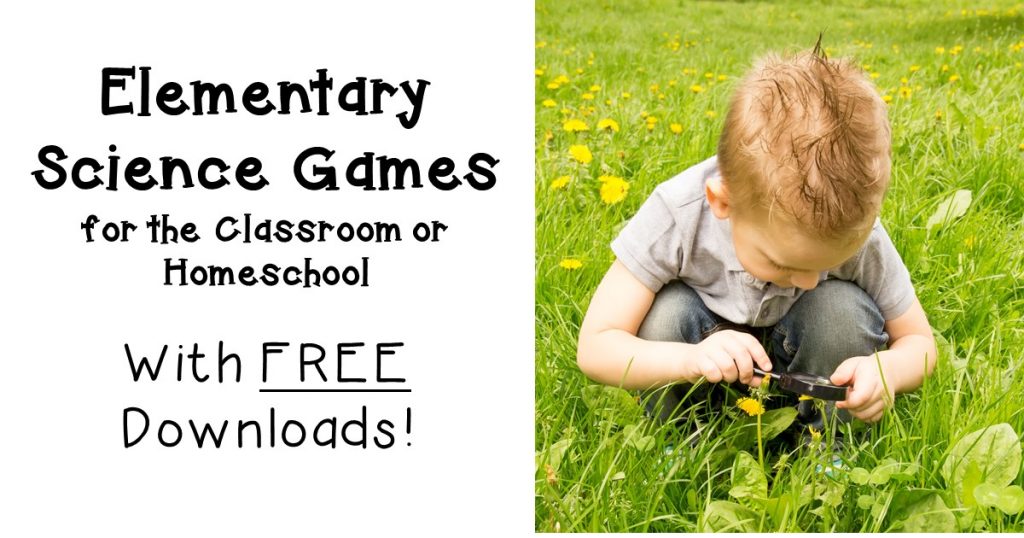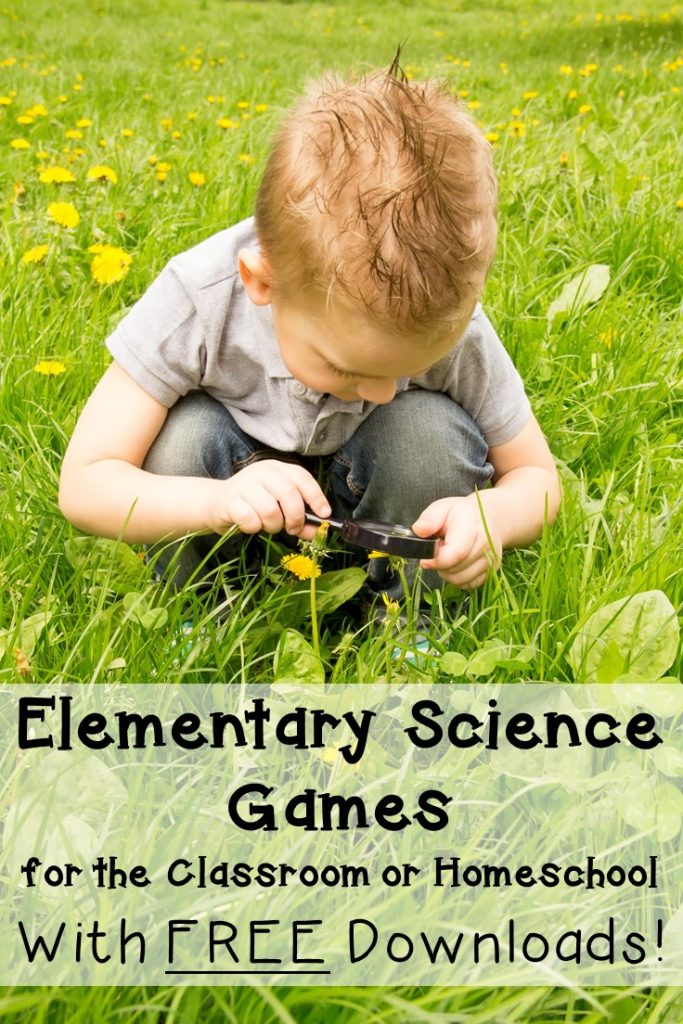Sarah is here today to share some elementary science games that your classroom or homeschool students are sure to love!
Teaching Elementary Science Games
Games can be used to effectively teach early elementary science topics. Active participation encourages learning. Games encompass the three main learning types: kinesthetic, auditory, and visual. They are played by doing (kinesthetic), students listen to directions (auditory), and the rules are often modeled (visual). I have taught science to varying ages using games for seventeen years. There are many benefits, supported by research, to integrating movement and play into your classroom.
The benefits of movement: Increased focus & elevated brain function
On a basic, physiological level, more movement = more blood flow and more blood flow = more oxygen moving throughout the body. Oxygen is necessary for the brain to function; so if one moves more, one’s brain will be more stimulated, focused, and active. Scientists have found that movements such as spinning, rolling, jumping, and crawling help to increase children’s attention spans.
When the entire body and it’s various systems are engaged in a learning activity, students are more likely to remember the information. For example, in the game Caterpillar Camouflage, students walk through the woods while looking for different colored pieces of yarn, the “caterpillars”. They make a tally mark on a chart next to the colors they find. After their search is concluded, the students compare their findings. Usually, the largest numbers found were the brightest colored caterpillars. The caterpillars that were colored similarly to the forest floor, had fewer numbers found. This game engaged students’ muscles though walking, their eyes while searching, and their brains while marking tallies and then discussing their findings with their peers. Due to all of these different systems and senses being engaged in a task, the concept of camouflage was understood on a deeper level.
The case for teaching cooperation (appropriate social skills, conflict resolution, trust-building)
Not only do games teach and reinforce science topics, participants are engaged in intricate lessons on social skills, conflict resolution, and building trust. During the games, students learn appropriate social behaviors and interactions through practice and discussion. Disagreements may arise during a game regarding who is out, who caught the ball, etc. Experiences like these are excellent places to exercise communication and conflict resolution tools. Additionally, through team play, students learn how to depend on teammates as well as help each other toward a common goal. Strong observation skills are paramount to developing more complex scientific skills.
An Unnatural Object Hike encourages group cooperation and trains students’ observation skills as they find items that may be out of place in the outdoors. Unnatural objects such as an eraser, a paper clip, a book, some fabric, spectacles, a mug, and a pen are hidden along a path with a start and finish. This is not a race, rather, the boundaries exist so the children know where to look. In groups of three to four students, they walk the trail together and note down what they find and where the object is located.
The students practice working together as they must wait for everyone in their group. Additionally, they need to listen to all the members as different people may spot different objects. Once all the groups have made their observations, a discussion centered around questions such as were there certain objects that were found first, why might that be, were all members of the group looking in the same direction or did different people have individual strengths that helped the group, can help to bring deeper meaning to the students’ experiences of observing and working as a group.
Using inquiry-based learning through games
Inquiry-based learning is guided by a facilitator who poses questions or problems for students to solve. Through this experience, students learn and make discoveries. Elementary science games and movement activities can help students work through problems by trying out different scenarios.
For example, in a game called Squirrel Nuts, students are invited to behave as squirrels do when they make caches of nuts for their winter food. Using a certain amount of beans as their food, students are given 1-2 minutes to hide the food in an area of predetermined borders. The facilitator guides the squirrels through several rounds of varying amounts of time representing different experiences in the winter (e.g. snowstorm, subzero temperatures, thaw).
In each of these rounds students gather some of their caches to survive the event. For example, the facilitator might say there is an early snowstorm, the squirrels have 1 minute to gather 6 nuts to help them survive the storm. Once the students return, the facilitator reviews which squirrels found the six nuts; those that did not, starved and sit out for the rest of the game. Rounds continue as long as the facilitator chooses.
The group reflects on their experience at the end of the game guided by questions such as, did any students get nuts from a cache other than their own, did any students find some of their beans had been stolen, was it better to hide your food in one place, or in several? The game and debriefing questions blend movement, critical thinking, and social interactions to encourage students to form a more personal connection in an effort to understand the concept of survival.
We hope these elementary science games work well for you with your classroom or homeschool students. But if you’re on the lookout for even more, check out these free and paid resources:
- FREE No Prep Outdoor Exploration Activities and Games
- FREE Food Chain Cards and Lesson Plans
- No Prep Predator and Prey Games
- Get Outside: Sharpening Adventure Skills
Sarah



I love the focus on the outdoors.
Thanks!
Carrie